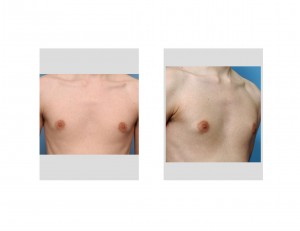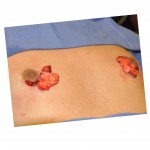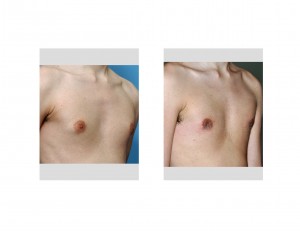Background: Gynecomastia is a well-known male condition of breast enlargement. Most envision gynecomastia as that of a significant breast mound that may be fairly small to that of a mound more similar to that seen in the more mature female breast. But smaller size gynecomastia exist in equal numbers which can be just as bothersome to the younger male.
Breast enlargement relegated to just around the nipple area can be defined as areolar gynecomastia. Appearing as a ‘puffy nipple’, the development of a small areolar mass pushes it out beyond the plane of the surrounding chest skin. While minor compared to much larger gynecomastias, it can be of cosmetic concern as it can appear through t-shirts and is not consistent with our modern-age culture of the ‘Abercrombie Fitch’ male. A completely flat chest is what younger males desire today. In the aesthetically conscious young male, any degree of nipple protrusion can be bothersome.

The treatment choices for any small form of gynecomastia is between liposuction versus open excision, or some combination of the two. Which choice is best depends on how the gynecomastia feels. If it is soft, liposuction (particularly laser liposuction or Smartlipo) can do a good job. If it feels hard or has a ‘mass-like’ feel, open excision will be more effective. It is tempting to think that one can beat up the hard areolar mass by liposuction cannulaes or laser probes and suction it out, but this approach will often be disappointing.


Case Highlights:
1)Areolar gynecomastias are small nipple protrusions that can be cosmetically disturbing, particularly in the younger male.
2) Despite their small size, they are usually not best reduced by liposuction due to their firm consistency. Open excision is more effective for getting out these silver-dollar sized masses.
3)The use of open excision for areolar gynecomastias creates no significant scarring and is no more invasive than liposuction. Overzealous tissue resection can result in nipple indentations and inversion.
Dr. Barry Eppley
Indianapolis Indiana



